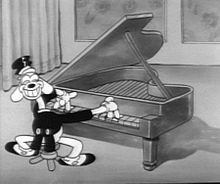Goopy Geer (film)
Appearance
| Goopy Geer | |
|---|---|
 Goopy Geer playing the piano. | |
| Directed by | Rudolf Ising |
| Produced by | Hugh Harman Rudolf Ising Leon Schlesinger |
| Edited by | Bernard B. Brown (uncredited) |
| Music by | Frank Marsales |
| Animation by | Isadore Freleng Rollin Hamilton Bob Clampett (uncredited) |
| Layouts by | Isadore Freleng (uncredited) |
| Backgrounds by | Art Loomer (uncredited) |
| Color process | Black-and-white |
Production company | |
| Distributed by | Warner Bros. Pictures The Vitaphone Corporation |
Release date |
|
Running time | 7 minutes |
| Language | English |
Goopy Geer is a 1932 Warner Bros. Merrie Melodies cartoon short directed by Rudolf Ising, featuring the first appearance of the title character.[1] The short was released on April 16, 1932.[2]
Synopsis
The customers in a nightclub clamor for Goopy Geer, who then comes out on the stage and entertains them by playing the piano, first with his fingers and his ears, later with his animated gloves. He's soon accompanied by a girl who tells a joke and sings a song.
Meanwhile, the customers eat and carry on in slapstick ways, and two coat racks dance together.
Toward the end, a drunken horse spits fire and destroys the piano, but Goopy keeps right on playing.
Notes
- Two scenes—one involving a waiter, the other the drunken horse—are reused from the earlier Foxy short Lady, Play Your Mandolin! Also, one of the customers, a fat lady hippo, had also appeared in a Foxy short, Smile, Darn Ya, Smile!
- Goopy bears some resemblance to Disney's (unnamed at the time) Goofy who first came along 39 days later.
References
- ^ Beck, Jerry; Friedwald, Will (1989). Looney Tunes and Merrie Melodies: A Complete Illustrated Guide to the Warner Bros. Cartoons. Henry Holt and Co. p. 10. ISBN 0-8050-0894-2.
- ^ Lenburg, Jeff (1999). The Encyclopedia of Animated Cartoons. Checkmark Books. pp. 104–106. ISBN 0-8160-3831-7. Retrieved 6 June 2020.
External links
Categories:
- 1932 films
- 1932 animated films
- 1930s American animated films
- 1930s animated short films
- American short films
- American animated short films
- American black-and-white films
- Animated films about dogs
- Films scored by Frank Marsales
- Films about music and musicians
- Films directed by Rudolf Ising
- Films featuring Goopy Geer
- Merrie Melodies shorts
- Warner Bros. Cartoons animated short films
- American films
- Warner Bros. animated short films, 1930s
- Merrie Melodies stubs
